Unappreciated flagship
It just so happened that around me just a bunch of Samsung devices. Galaxy S (9000) for the younger sister, S + (9001) for the girl, S II (9100) for me, R (9103) - for a friend, there are Galaxy Tabs in different versions ... In general, a sufficient set to clearly represent what are the products of this company.
And I remember well how many rumors around him that the forthcoming Galaxy S III had been gathering almost since the end of 2011. There were fake concepts on the Internet, someone claimed that the phone would be almost titanic, some said that the resolution of the camera would double, the third were for the retina-class screen with FullHD resolution. We went on the Internet and pictures, and videos of different versions of the prototype of this device, in general - there were enough rumors, everyone was waiting for different, but it was absolutely worth waiting for a response to the main competitor flagship - the “size” and the main set of characteristics, you can say, releases the first flagship in the current generation. All the rest are trying to catch up and overtake, both in performance and in software.
And now, in the courtyard - the end of April, very soon the S III exit, on May 3 a special event was appointed, and not just anywhere, but in London. Shortly before the event images of the Galaxy S III fall into the network. Begins, fuss, because how ...

In some, there is still a hope that this is another fake or just a troll-action of Samsung, someone immediately recorded the device in the “failures of the year”, in me, personally, there was still hope. No, well, the flagship of Samsung, which twice confirmed that it can do top-level devices, can be bad, can't?
And here it is, the long-awaited presentation. The scene is carried out exactly what they saw in the pictures. The people are at a loss, yes, the performance characteristics look very impressive: the new processor, HD screen, high-speed camera, good battery performance, but what about the case? Forms? Materials? Plastic? In general, in my memory, this is the most controversial acceptance of the flagship apparatus in society. Then, somewhat disappointed, I turned off the screen of my S II and went to bed - I met the long-awaited novelty on the St. Petersburg-Moscow train. The train pounded with wheels, and thoughts flooded in my head, which, perhaps, were visited by many habrayers, who, just like me, were waiting for the presentation, divided the news and waited for a device that would leave everything that was sold at the moment far behind. Yes, my first impression was disappointment. Unjustified hopes.
A couple of months later, the S III appeared with a friend in the Czech Republic. Then one more, this time in Russia. I, remembering my feelings and thoughts after the presentation, did not even read the reviews of this device. In general, after some time, I saw the S III on the street, in the hands of people. Then he managed to turn it in his hands, poke it. Well, just recently (thanks to a new acquaintance), the guys from Samsung contacted me and asked if I wanted to take the S III for a test and write about my impressions. Well not to refuse such an opportunity? That's how I spent a whole week with this phone. It is about his impressions, about what has changed, and what remains the same, what was cured, and what - could not and will be this post.
')
And I'll start, perhaps, with the most promiscuous part of this unit: the case.
He was kicked for the form, he was kicked for the plastic, he was kicked for the form and the plastic at the same time, in general, many unflattering words were thrown at him. (No, well, what were you waiting for, a big iPhone? Apple would have sued Samsung before the end of the presentation!) So, you can safely throw 90% of it to the dustbin of history. Housing - what you need. How is it in the classic reviews do? The case is made of plastic, “rounded”, “pebbly” form (the designers of the S III named it so, they say, were inspired by natural forms and all that), made in the form factor “monoblock”. Here it is next to its predecessor:
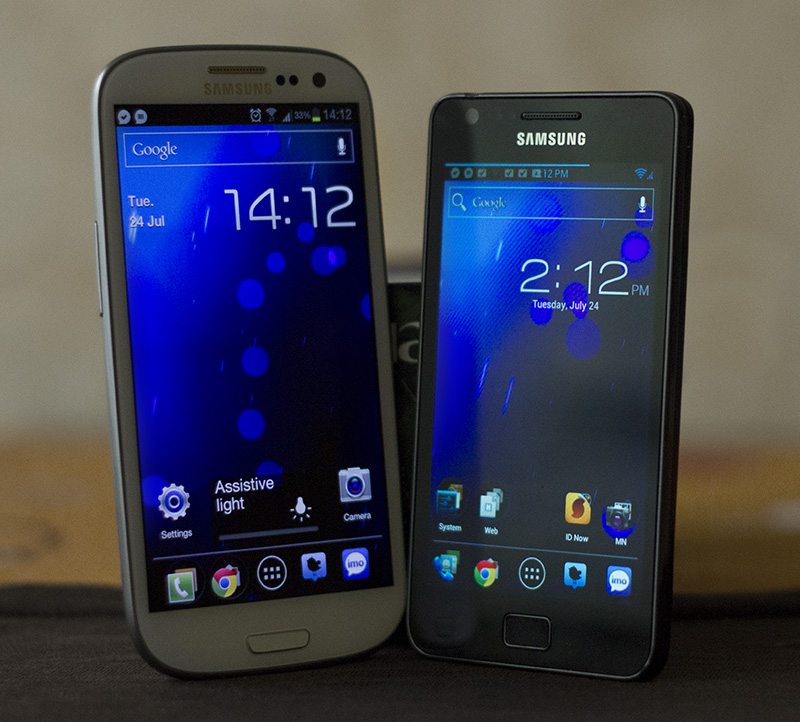
The front part is completely covered with protective glass. In the upper part - neat mesh dynamics, light sensor, front camera, LED indicator (hallelujah!) And proximity sensor.
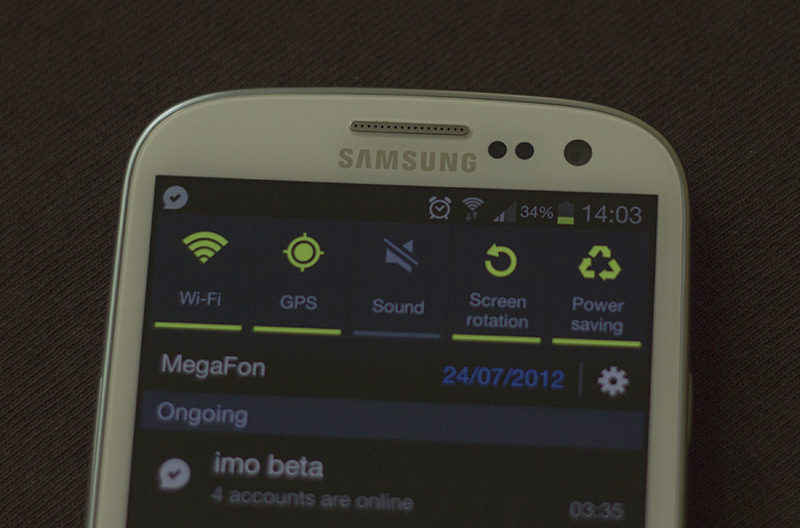
In the lower part there is a modest “home” button that significantly altered the shape, compared to previous generations of Galaxies, two touch buttons, “back” and “menu / options”, which remained in their usual places and were not swapped, like many manufacturers ICS exit. The backlight of the side buttons is turned on only when it is needed (the light sensor is responsible for this), and it is perfectly visible in the dark.
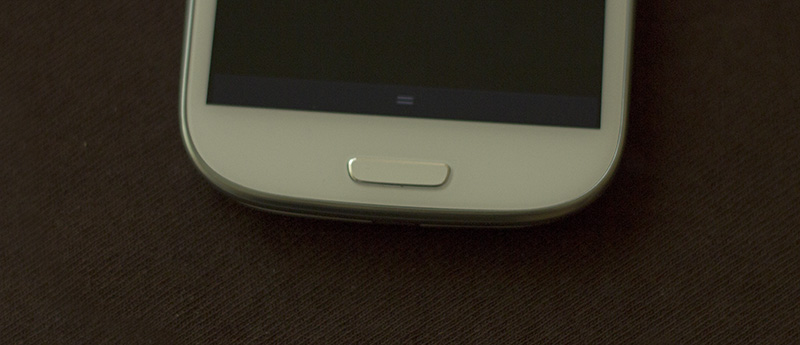
The side faces are decorated concisely: a neat rim of plastic, with a fine polished texture for aluminum, on the left side is a swing button responsible for volume.
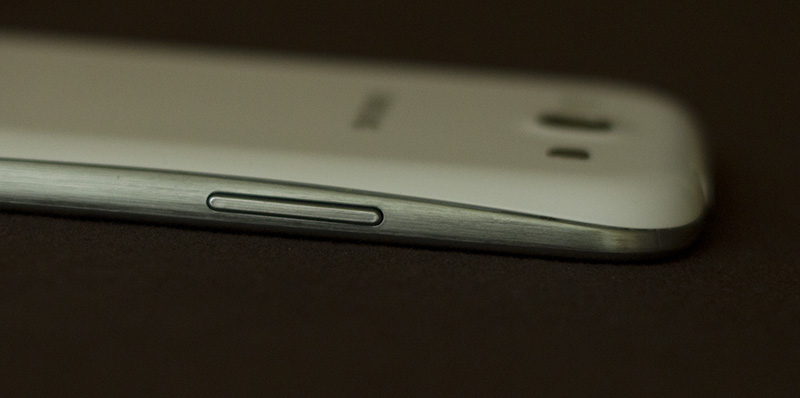
On the right - the off button, it is also responsible for locking / unlocking, although the last action can (and, I confess, more often I did just that) through the “home” button on the front panel.
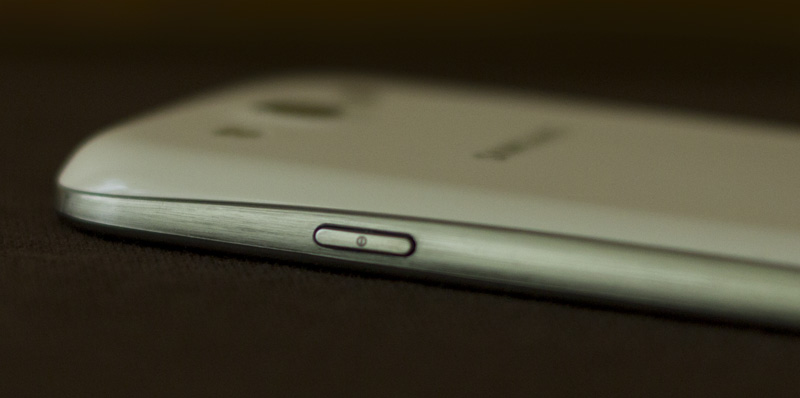
The back panel is austere, with only “Samsung” inscription on it, made in a proprietary font, the camera’s “eye” with a flash, speaker holes used for a speakerphone or ringing tone, that's all.
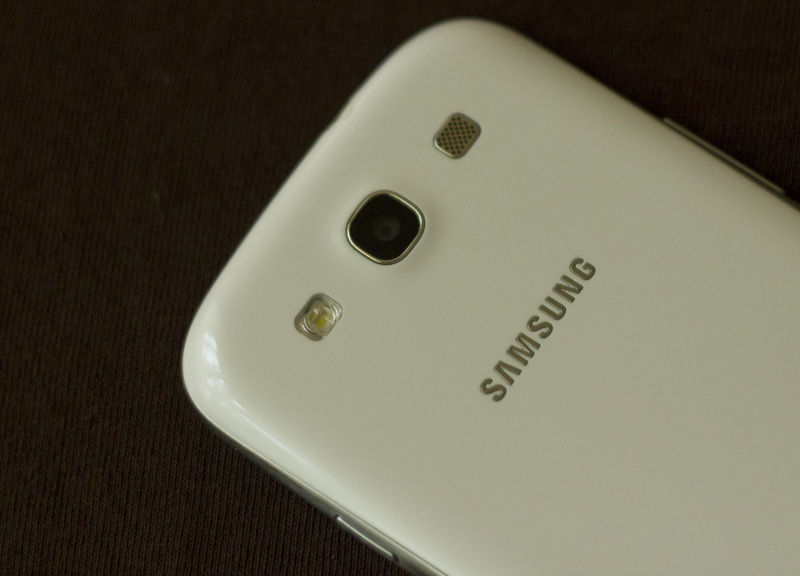
The lid itself is as thin as its predecessor, the Galaxy S II (it was also called “gasket”). True, this time it is not flat, because of the shape of the case, the back cover also contains “sidewalls”, like the very first “Galaxy” S. I hope this will add a few points to it in terms of survivability, although I’m SGS cover II don't call unreliable, especially considering how many times I shot it.
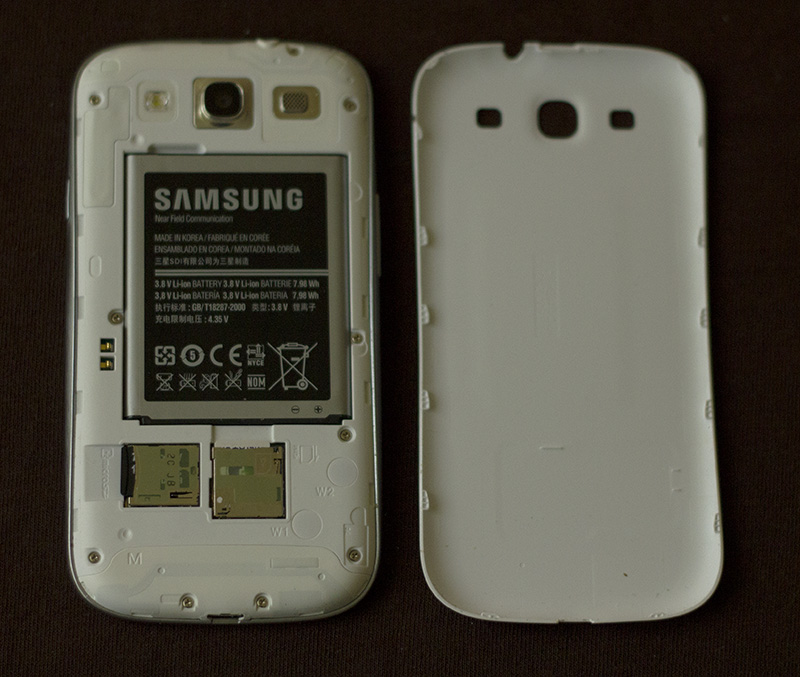
Under the lid there is a battery compartment (removable), MicroSIM (a tribute to fashion, not otherwise, since there was quite enough space for an ordinary one), MicroSD (another stone in the rock garden of the main competitor from Taiwan).
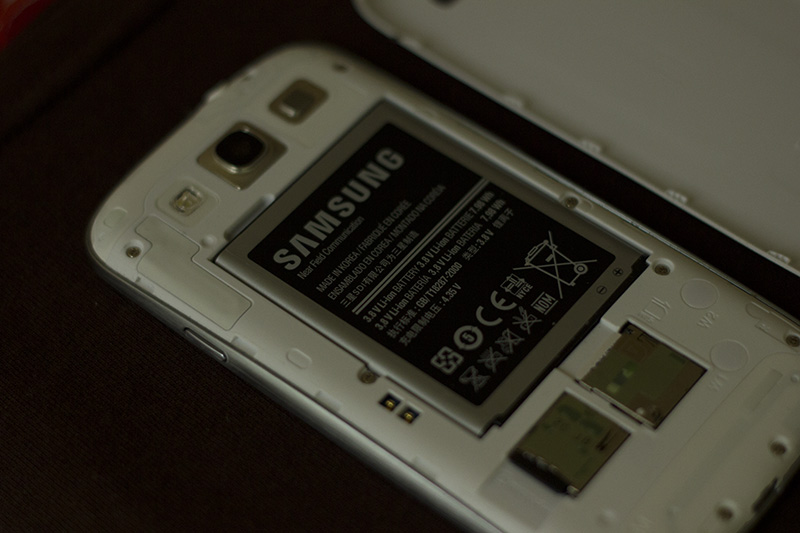
All elements of the body are made of plastic (well, except for the protective glass). The form is quite convenient, the device fits well in the hand, and other overview blah blah blah.
So, back to the criticism. Yes, it is not made of polycarbonate or lumi- num, it does not have a titanium alloy or asbestos chips, it does not constitute anything supernatural. But for now, this case is the only one that can accommodate a 4.8 ”screen and does not turn out to be a huge and uncomfortable shovel.
The surface is neatly rounded, the phone is perfectly in the hand and does not slip at all. The only thing worth considering is that the grip of this phone will be slightly different from the one that devices with a screen diagonal of 3.7 "- 4.3" usually hold. I retrained the day, and at first experienced some discomfort, but then everything became OK
Out of habit, the phone falls into the hand like this: three fingers under the back cover, the bottom end rests on the little finger, the thumb is poked into the screen. With this way of holding the phone, he does not strive to “slide out” down, or rather, there is no feeling that he is capable of it, the body, as I said, is not slippery.
However, you will either need a very long thumb, or constantly intercept the device in order to reach the top of the screen. I would call correct holding “4 fingers behind”, in which fingers cover the phone in the center, keeping it evenly in the center of mass. The little finger can slightly lead to the lower part of the body, if you think that the lower part outweighs. He is unlikely to slip down, but in what unfortunate case - he pushed, touched, stumbled, and anything - less chance that “holtecco” will become “dangerous” - throwing “forward” through the finger does not threaten the device.
If with the back of the case, in principle, everything is clear, then the front is also not as simple as it seems. Look carefully at the photo:

See how the light reflects on the edge of the screen? The edges of the protective glass are neatly rounded to the edges (hello, “pebble” shape!), There is no “sharp” frame or edge, as was the case in the Galaxy S II / Galaxy Note or in the Cupertine Box. It feels like it really reminds water-polished pebbles. I believe that this is one of the best finds in the design of this device, which allows you to continue using the phone 90% of the time with one finger, without straining and pulling it out, and generally making the device much more pleasant to touch. The glass itself has also changed, if on S II the finger slid so-so, especially after several months of intensive use, here - a very smooth and high-quality material - to communicate with the touchscreen is one great pleasure. He works perfectly on touch, no false positives - no, he suffers even wet hands - my SII just goes crazy if his hands are a little wet.
What else has caused the discontent of the community? PenTile matrix in the screen? Well, yes, I agree, the fact that the screen shows “not fair” pixels is a bit depressing. Yes, not even the fact that it would “oppress”, does not leave the thought that we somewhere ... did not cheat. For our money. What happened to this screen? The first galaxy (and the galaxy +) had a PenTile matrix of 480x840 with a diagonal of 4 inches. From her I just itch my eyes - I see a grid of pixels and gaps between them. The screen wants to pick out the machine, smash with a hammer, pass through a meat grinder, grind in a blender and force the creator to eat the mixture.
Dissatisfied, apparently, there was a lot, since the Galaxy S II was already another matrix - SuperAmoledPlus, with the classic RGB pixel layout model and excellent picture quality. Yes, by resolution, it was slightly inferior to the mainstream 960x540, which became at that moment, but this did not affect usability, the picture quality, color reproduction and deep black color were different: unlike the “sensational” competitor, SGS2 was sold very successfully from the very start.
But here comes the Galaxy Note - 5.3 inch “ceiling” with SuperAmoled matrix HD-class. And what do we see? Lack of plus sign. And that means ... Yes, yes, PenTile is back. True, the resolution is now 1280x720 with a diagonal of more than five inches. And it was - 800 x 480 by four inches. In general, with this screen size and resolution, the main drawback of PenTile has practically ceased to be noticeable. If you remove the backlight to a minimum and bring the smartphone very close - the pixel grid is barely noticeable; a little more obvious than the “steps” in Recovery, however, it uses monochrome text on a black background, besides blue.
In SGS III there is a matrix made using the same technology as the “Notes” matrix, only the diagonal has become significantly smaller. This means that the pixel density has increased in proportion to the reduction of the screen area, the resolution has not changed! Now the pentile grid can be seen only if you put a neat drop of water on the screen in the place of a contrast transition and reduce the backlight to reasonable limits. With the naked eye to distinguish the pixels will not work in any way. Here is a comparison of matrices SGS, SGSII, SGSII LTE, SGS III:
itc.ua/wp-content/uploads/03-3-GALAXY-SIII-Pentile.jpg
As you can see, the dimensions of the pixel block have significantly decreased, and even if the eye has nothing to catch on, does it matter whether the matrix is “honest” or “dishonest”?
The display quality is at its best, the picture is clear, bright and sharp. By the way, the color rendition is regulated, there are four profiles in the phone itself, everyone is free to choose what he likes more, here is an example of a photo with four different settings:
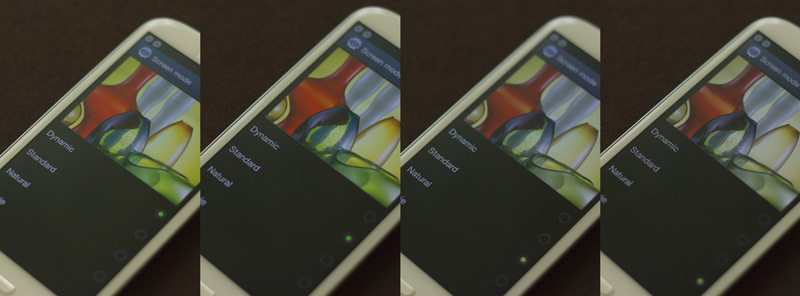
It should be noted that the screenshots do not change when the color model is changed, which means that it is not the digital “enhancer” that is working, but the parameters in the driver or screen controller itself, which directly sends the already formed image to the display. So if PenTile is absolutely not noticeable in everyday use, and it allows you to make the device cheaper / save electricity / save the children of Africa / make MOAR Kittens - let it be. When using it, the discomfort no longer causes, the screen surpasses the previous flagship model in terms of the quality of the displayed picture, what else do you need, dear users of mobile equipment?
The third part of Marlezonsky ballet: software and Samsung proprietary shell. Frankly, the first thing I did when I bought myself a second galaxy - I took down TouchWiz and replaced it with a third-party launcher. There were a lot of people dissatisfied with the functionality of native homescreens. The main non-standard interface of the Taiwanese rival SenseUI was inferior in almost everything, starting with usability and absurd limitations, ending with parrot design. The appearance forced us to cry with crocodile tears, the speed of work was infuriating, and first of all, when buying a Galaxy S / SII, friends were recommended to install any other launcher and lockscreen. Just because the mother - a continuous source of sadness and grief. At least he was.
Now this jamb is fixed: the desktop manager is smooth and fluid, like water, loxgrin is convenient, the number of desktops easily decreases or increases, widgets are no longer a crowd of mixed and colorful clowns. And if this is not a business style, then at least - a pleasant consumer design.
The “menu” button, which hides the applications in itself, behaves simply amazing. One kind of inconspicuous, fluid and simple movement, and the desktop “flowed” in AppDrawer. The theme of WaterFlow is permeated here, but it is this animation that is the pinnacle of the ideology itself. I often notice that people who hold SGS III for the first time open / close menus several times in a row, viewing this tricky animation. Mesmerizing.
Yes, this software didn’t do without a spoon of tar; in the notification panel there are switches of various elements of wireless communication, and this list of switches has two jambs: it does not customize (or I didn’t find how to do it), and a long tap does not lead to a specific at the construction site. However, there is also a "gear", which immediately displays a list of all the settings. Okay, so be it, a couple more tapas are longer, not fatal. Anyway, the device works smartly, longer with a finger to hold a long tap. Well, another “joint” - a huge separator between desktops and “dock” at the bottom of the phone. It occupies a whole row on which 4 more icons could be placed. It turned out badly.
In addition to homescreen and other Bells and Whistles, the GS III also has an excellent out-of-box feature set. On it stands S-Memo, which is already familiar to SGNote users, without the S-Pen, of course, drawing is not very convenient, but it is quite possible (the picture is cropped):

Yes, and attention to detail pleases, for example, the phone starts to vibrate, if you took it in hand, and you have missed calls or SMS. There is a feature SmartStay, which does not turn off the screen and does not reduce the brightness to a minimum while you are looking at the screen of the device. Thanks to this, you can set the backlight timeout for 15 seconds instead of 30-45 in SGS II, when reading something in the browser, or just in everyday life, the thing, as it turned out, is almost irreplaceable. The lack of it on SGS II is now just infuriating.
The new phone also has a funny feature - Direct Call: when dialing SMS or viewing contact details, you can simply bring the device to your ear - he will call. Used a couple of times, it works without failures, it is quite convenient. I think, over time, you can get used to it, but I do not call so often, so, for me personally, this is a funny thing, nothing more.
Who else had any complaints about the device? The camera did not raise the resolution? And what the hell is with him, have you seen the pictures? Clear, bright, juicy, with a VERY large viewing angle (which really pleases, I haven’t seen such a “width” on the phones yet. The camera itself can take up to 20 shots, the delay in the electronic shutter is almost absent, and the video is just fine Yes, this is exactly what the photo-flagship is. Why does the phone have more than 8 megapixels if the optics cannot reveal them anyway? Here is an excellent balance of performance, quality and facial progress. I specifically took three different generations of devices: Galaxy S ( in fact - S +, but camera modules there are practically no differences), S II and S III, and made the most “identical” frames for all three. See for yourself, compare, do anything, but S III is cool.
Here is an example of a photo: www.mediafire.com/?uxny8m2pna1190u (pardon that so little - my girlfriend formatted the memory card by mistake, restored what it was) :(
Here is an archive with photos for all three devices: www.mediafire.com/?uxny8m2pna1190u
Here are some video examples: www.mediafire.com/?2x28ymqq58vbcpu
After I returned to the daily use of the previous model, the camera was the first thing I missed. I often find all the funny stuff that you have to take on the go. The quality of frames and the speed of the first frame / rate of fire are often decided, and after 5 seconds, what I wanted to capture can simply not exist / disappear from view. In general, the camera is one of the strongest features of this device, especially if you once climb through the settings, take out what is needed for quick access, turn on the electronic stabilizer. Here are some more photos taken by the third galaxy on Yandex pics . On the phone screen, by the way, they look much better than on the computer.
Settings at the camera - a dime a dozen:
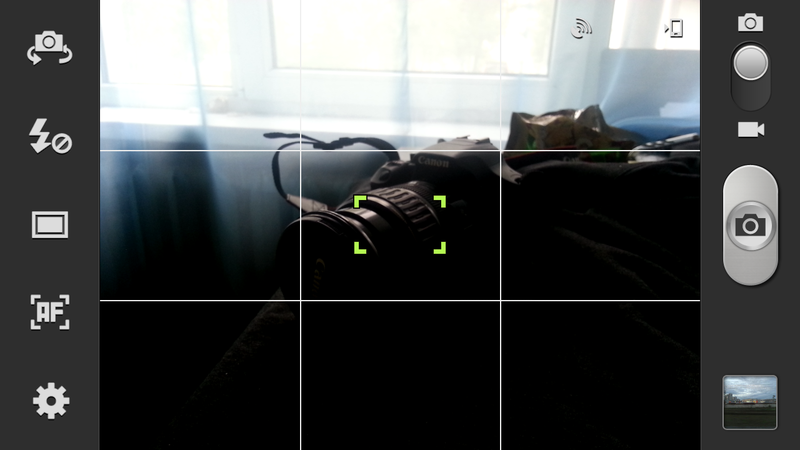
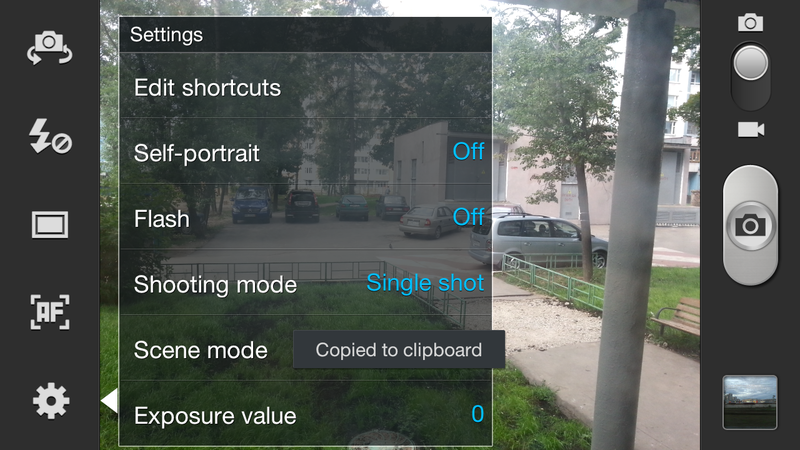
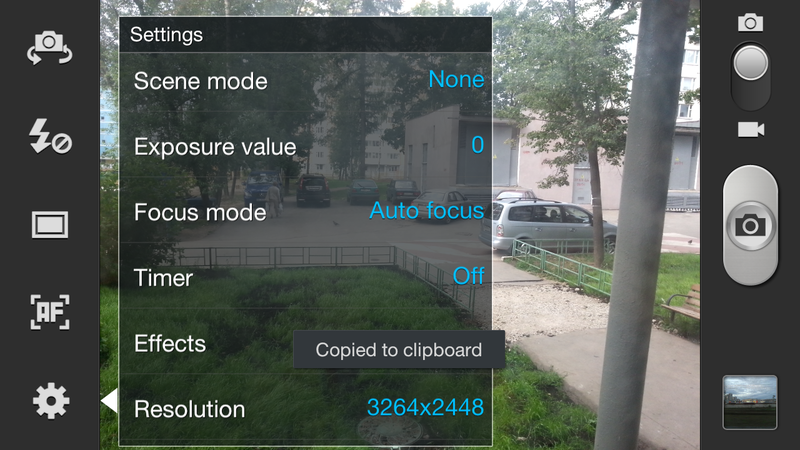

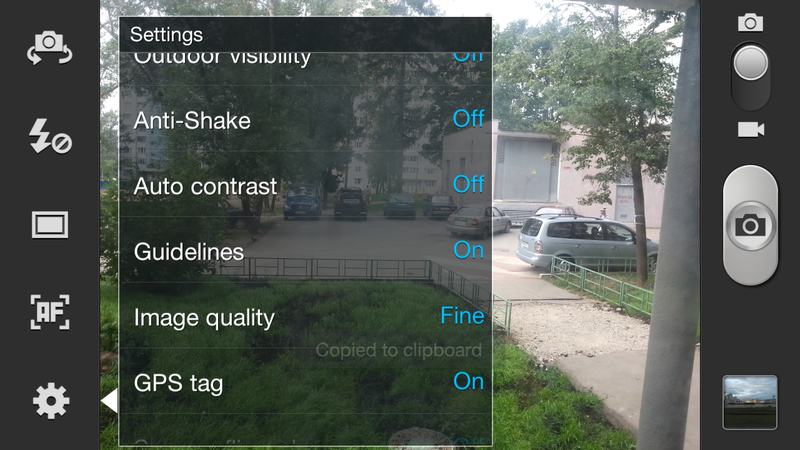
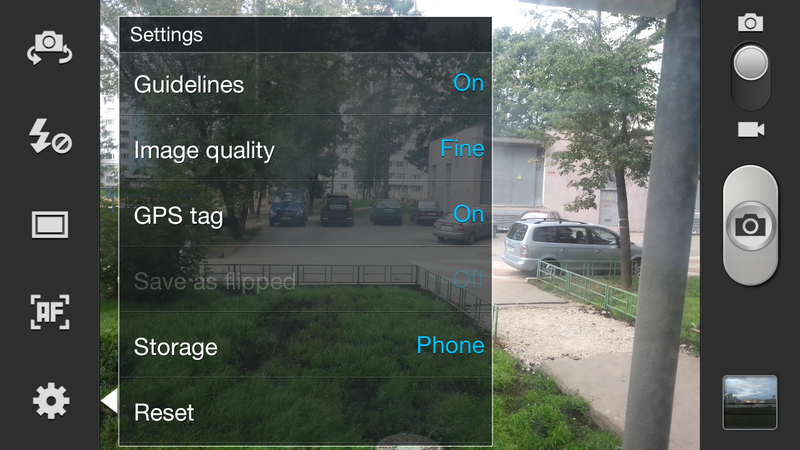
Many of them can be brought to the left quick access panel. The only noticeable negative - by default, AntiShake is disabled.
About the performance of this phone you can hardly say anything bad. What do we have in the European / International (that is, our) version inside?
Directly the characteristics of the phone:
CPU: 1.4 GHz, quad-core Samsung Exynos 4 Quad. ARM A9 architecture;
GPU: ARM Mali-400MP4, quad-core, 256KB cache, support for OpenGL ES 1.1 & 2.0, OpenVG 1.1;
RAM: 1GB;
Built-in memory: 16/32/64 GB.
Wireless interfaces:
Wi-Fi B / G / N;
Bluetooth version 4.0;
NFC;
2G - 850, 900, 1800, 1900 MHz, GSM / GPRS / EDGE;
3G - 850, 900, 1900, 2100 MHz, UMTS / HSPA +;
4G is not in this version.
Other:
Slot for microSDHC memory cards;
8MP camera with BSI technology;
Battery 2100 milliamps / hour.
Yes, everyone expected Samsung to deliver two gig of RAM, just out of harm. No, the version for Europe based on the quad-core Exynos got “just one gig”. (For Koreans and Americans, the dual-core Qualcomm with Adreno 225 costs 2GB as compensation). A pitiful, subtle gigabyte of RAM. In the smartphone. People, wake up! Where are you more in the smartphone? I don’t know what needs to be done so that there is a small amount of such RAM, I didn’t have any problems with the performance of the second galaxy either in performance or in toys or in everyday life, which is on firmware 2.3.7, which is 4.0.3 that on third-party Roma.
The third, in my opinion, does not know the word “slow down” at all. Everything flies: what toys, what benchmarks, what reviews on numerous resources. So what is it, and in performance it is the # 1 flagship among the phones at the moment, and only the solution on the Qualcomm Krait with four cores and Adreno 320 will be able to counter it. When it comes out. I had the opportunity to use not only Samsung'ami, but I also held all fresh devices with qalcomms, TiOMAP and various Tegres. So far, nothing on Android 4.0.x impressed me with speed as this device. What will happen with the arrival of JB - I do not know, but it will not be worse for sure, because Those Roma that I have already seen on the Samsung Galaxy Nexus and on my S II pleased me both in terms of performance, and in terms of the next minor fixes in the UI and the integration of applications into the system. It will be funnyif the second and third galaxies get “jelly” faster than their main competitors, who came out earlier. We can only say two words about game support: everything works. Well, or add three more: forget about the brakes.
As far as autonomy is concerned, I have nothing to say: until the evening the device lives confidently, the main consumer is a 3G connection, and, to put it mildly, insufficient coverage of 3G networks of our Great Mighty Immense Homeland affects. You can watch movies on it for 8 hours, and another half of the battery will remain if the wireless interfaces have been turned off. At least 4 hours of TV shows, he ate about 20% of the charge. Hour GTA 3 ate about 10-12% of the battery, which can also be called a good result.
I don’t even know what else could be said about the third galaxy. At the time of release and announcement, I reacted to the new product with extreme skepticism; Samsung, forgive me, I take my words back.
This device - the best that at the moment I saw in the field of mobile devices. Uncompromising performance, convenient (!) Design, excellent camera (stick to the fourth galaxy and stabilize the matrix, so that competitors can be wiped again), excellent indicators of autonomy, despite the advanced stuffing.
I am ready to forgive PenTile in the screen, I am ready to forget that the device is not made of alloys that fly into space, it doesn’t give a damn about the fact that it has 1 GB of RAM. A year’s supply of cynicism and a bucket of bile just disappeared after a week with SGS III, and it wasn’t enough to give it back (it’s a pity, as you know, for a bee), I just didn’t want to part. After it, the SGS II seems small, its camera is helpless, and its autonomy is a weak point (although in its time it did all the flagship devices for battery life).
Instead, the results:
Samsung Galaxy S III - the most controversial and undervalued flagship in the history of Android-devices. Maybe we waited too much, maybe they just “got stuck”, maybe Samsung didn’t very well submit a novelty at its event in London.
Here are just SGS III - the fastest gadget in history. From the announcement to the release of the model to the market, 9 million pre-orders were placed, and with the start of sales, factories simply could not cope with the release of the required number of devices.
The Third Galaxy became the official phone of the Olympic Games 2012, they look at it with frank interest in transport, and all Euroset do not even think of lowering the impressive price tag of 30 kilo rubles, why, they take it anyway.
Engineers said they were inspired by water - they did not lie. The device is very smooth and fluid in work, no jerks, no corners, everything is smooth, fast and very pleasant.
Samsung, thanks, once again gave a kick in the Android device industry.
Well, since the topic has long been lying in the drafts - the beginning of the article is a bit outdated. At home, I had two more SGS III at home, and even two friends had these devices. It is a little sad that the red, black and gray devices will only start coming out - I would take a gray one.
And I remember well how many rumors around him that the forthcoming Galaxy S III had been gathering almost since the end of 2011. There were fake concepts on the Internet, someone claimed that the phone would be almost titanic, some said that the resolution of the camera would double, the third were for the retina-class screen with FullHD resolution. We went on the Internet and pictures, and videos of different versions of the prototype of this device, in general - there were enough rumors, everyone was waiting for different, but it was absolutely worth waiting for a response to the main competitor flagship - the “size” and the main set of characteristics, you can say, releases the first flagship in the current generation. All the rest are trying to catch up and overtake, both in performance and in software.
And now, in the courtyard - the end of April, very soon the S III exit, on May 3 a special event was appointed, and not just anywhere, but in London. Shortly before the event images of the Galaxy S III fall into the network. Begins, fuss, because how ...

In some, there is still a hope that this is another fake or just a troll-action of Samsung, someone immediately recorded the device in the “failures of the year”, in me, personally, there was still hope. No, well, the flagship of Samsung, which twice confirmed that it can do top-level devices, can be bad, can't?
And here it is, the long-awaited presentation. The scene is carried out exactly what they saw in the pictures. The people are at a loss, yes, the performance characteristics look very impressive: the new processor, HD screen, high-speed camera, good battery performance, but what about the case? Forms? Materials? Plastic? In general, in my memory, this is the most controversial acceptance of the flagship apparatus in society. Then, somewhat disappointed, I turned off the screen of my S II and went to bed - I met the long-awaited novelty on the St. Petersburg-Moscow train. The train pounded with wheels, and thoughts flooded in my head, which, perhaps, were visited by many habrayers, who, just like me, were waiting for the presentation, divided the news and waited for a device that would leave everything that was sold at the moment far behind. Yes, my first impression was disappointment. Unjustified hopes.
A couple of months later, the S III appeared with a friend in the Czech Republic. Then one more, this time in Russia. I, remembering my feelings and thoughts after the presentation, did not even read the reviews of this device. In general, after some time, I saw the S III on the street, in the hands of people. Then he managed to turn it in his hands, poke it. Well, just recently (thanks to a new acquaintance), the guys from Samsung contacted me and asked if I wanted to take the S III for a test and write about my impressions. Well not to refuse such an opportunity? That's how I spent a whole week with this phone. It is about his impressions, about what has changed, and what remains the same, what was cured, and what - could not and will be this post.
')
And I'll start, perhaps, with the most promiscuous part of this unit: the case.
He was kicked for the form, he was kicked for the plastic, he was kicked for the form and the plastic at the same time, in general, many unflattering words were thrown at him. (No, well, what were you waiting for, a big iPhone? Apple would have sued Samsung before the end of the presentation!) So, you can safely throw 90% of it to the dustbin of history. Housing - what you need. How is it in the classic reviews do? The case is made of plastic, “rounded”, “pebbly” form (the designers of the S III named it so, they say, were inspired by natural forms and all that), made in the form factor “monoblock”. Here it is next to its predecessor:

The front part is completely covered with protective glass. In the upper part - neat mesh dynamics, light sensor, front camera, LED indicator (hallelujah!) And proximity sensor.

In the lower part there is a modest “home” button that significantly altered the shape, compared to previous generations of Galaxies, two touch buttons, “back” and “menu / options”, which remained in their usual places and were not swapped, like many manufacturers ICS exit. The backlight of the side buttons is turned on only when it is needed (the light sensor is responsible for this), and it is perfectly visible in the dark.

The side faces are decorated concisely: a neat rim of plastic, with a fine polished texture for aluminum, on the left side is a swing button responsible for volume.

On the right - the off button, it is also responsible for locking / unlocking, although the last action can (and, I confess, more often I did just that) through the “home” button on the front panel.

The back panel is austere, with only “Samsung” inscription on it, made in a proprietary font, the camera’s “eye” with a flash, speaker holes used for a speakerphone or ringing tone, that's all.

The lid itself is as thin as its predecessor, the Galaxy S II (it was also called “gasket”). True, this time it is not flat, because of the shape of the case, the back cover also contains “sidewalls”, like the very first “Galaxy” S. I hope this will add a few points to it in terms of survivability, although I’m SGS cover II don't call unreliable, especially considering how many times I shot it.

Under the lid there is a battery compartment (removable), MicroSIM (a tribute to fashion, not otherwise, since there was quite enough space for an ordinary one), MicroSD (another stone in the rock garden of the main competitor from Taiwan).

All elements of the body are made of plastic (well, except for the protective glass). The form is quite convenient, the device fits well in the hand, and other overview blah blah blah.
Housing
So, back to the criticism. Yes, it is not made of polycarbonate or lumi- num, it does not have a titanium alloy or asbestos chips, it does not constitute anything supernatural. But for now, this case is the only one that can accommodate a 4.8 ”screen and does not turn out to be a huge and uncomfortable shovel.
The surface is neatly rounded, the phone is perfectly in the hand and does not slip at all. The only thing worth considering is that the grip of this phone will be slightly different from the one that devices with a screen diagonal of 3.7 "- 4.3" usually hold. I retrained the day, and at first experienced some discomfort, but then everything became OK
Out of habit, the phone falls into the hand like this: three fingers under the back cover, the bottom end rests on the little finger, the thumb is poked into the screen. With this way of holding the phone, he does not strive to “slide out” down, or rather, there is no feeling that he is capable of it, the body, as I said, is not slippery.
However, you will either need a very long thumb, or constantly intercept the device in order to reach the top of the screen. I would call correct holding “4 fingers behind”, in which fingers cover the phone in the center, keeping it evenly in the center of mass. The little finger can slightly lead to the lower part of the body, if you think that the lower part outweighs. He is unlikely to slip down, but in what unfortunate case - he pushed, touched, stumbled, and anything - less chance that “holtecco” will become “dangerous” - throwing “forward” through the finger does not threaten the device.
If with the back of the case, in principle, everything is clear, then the front is also not as simple as it seems. Look carefully at the photo:

See how the light reflects on the edge of the screen? The edges of the protective glass are neatly rounded to the edges (hello, “pebble” shape!), There is no “sharp” frame or edge, as was the case in the Galaxy S II / Galaxy Note or in the Cupertine Box. It feels like it really reminds water-polished pebbles. I believe that this is one of the best finds in the design of this device, which allows you to continue using the phone 90% of the time with one finger, without straining and pulling it out, and generally making the device much more pleasant to touch. The glass itself has also changed, if on S II the finger slid so-so, especially after several months of intensive use, here - a very smooth and high-quality material - to communicate with the touchscreen is one great pleasure. He works perfectly on touch, no false positives - no, he suffers even wet hands - my SII just goes crazy if his hands are a little wet.
Pentile
What else has caused the discontent of the community? PenTile matrix in the screen? Well, yes, I agree, the fact that the screen shows “not fair” pixels is a bit depressing. Yes, not even the fact that it would “oppress”, does not leave the thought that we somewhere ... did not cheat. For our money. What happened to this screen? The first galaxy (and the galaxy +) had a PenTile matrix of 480x840 with a diagonal of 4 inches. From her I just itch my eyes - I see a grid of pixels and gaps between them. The screen wants to pick out the machine, smash with a hammer, pass through a meat grinder, grind in a blender and force the creator to eat the mixture.
Dissatisfied, apparently, there was a lot, since the Galaxy S II was already another matrix - SuperAmoledPlus, with the classic RGB pixel layout model and excellent picture quality. Yes, by resolution, it was slightly inferior to the mainstream 960x540, which became at that moment, but this did not affect usability, the picture quality, color reproduction and deep black color were different: unlike the “sensational” competitor, SGS2 was sold very successfully from the very start.
But here comes the Galaxy Note - 5.3 inch “ceiling” with SuperAmoled matrix HD-class. And what do we see? Lack of plus sign. And that means ... Yes, yes, PenTile is back. True, the resolution is now 1280x720 with a diagonal of more than five inches. And it was - 800 x 480 by four inches. In general, with this screen size and resolution, the main drawback of PenTile has practically ceased to be noticeable. If you remove the backlight to a minimum and bring the smartphone very close - the pixel grid is barely noticeable; a little more obvious than the “steps” in Recovery, however, it uses monochrome text on a black background, besides blue.
In SGS III there is a matrix made using the same technology as the “Notes” matrix, only the diagonal has become significantly smaller. This means that the pixel density has increased in proportion to the reduction of the screen area, the resolution has not changed! Now the pentile grid can be seen only if you put a neat drop of water on the screen in the place of a contrast transition and reduce the backlight to reasonable limits. With the naked eye to distinguish the pixels will not work in any way. Here is a comparison of matrices SGS, SGSII, SGSII LTE, SGS III:
itc.ua/wp-content/uploads/03-3-GALAXY-SIII-Pentile.jpg
As you can see, the dimensions of the pixel block have significantly decreased, and even if the eye has nothing to catch on, does it matter whether the matrix is “honest” or “dishonest”?
The display quality is at its best, the picture is clear, bright and sharp. By the way, the color rendition is regulated, there are four profiles in the phone itself, everyone is free to choose what he likes more, here is an example of a photo with four different settings:

It should be noted that the screenshots do not change when the color model is changed, which means that it is not the digital “enhancer” that is working, but the parameters in the driver or screen controller itself, which directly sends the already formed image to the display. So if PenTile is absolutely not noticeable in everyday use, and it allows you to make the device cheaper / save electricity / save the children of Africa / make MOAR Kittens - let it be. When using it, the discomfort no longer causes, the screen surpasses the previous flagship model in terms of the quality of the displayed picture, what else do you need, dear users of mobile equipment?
TouchWiz and other software
The third part of Marlezonsky ballet: software and Samsung proprietary shell. Frankly, the first thing I did when I bought myself a second galaxy - I took down TouchWiz and replaced it with a third-party launcher. There were a lot of people dissatisfied with the functionality of native homescreens. The main non-standard interface of the Taiwanese rival SenseUI was inferior in almost everything, starting with usability and absurd limitations, ending with parrot design. The appearance forced us to cry with crocodile tears, the speed of work was infuriating, and first of all, when buying a Galaxy S / SII, friends were recommended to install any other launcher and lockscreen. Just because the mother - a continuous source of sadness and grief. At least he was.
Now this jamb is fixed: the desktop manager is smooth and fluid, like water, loxgrin is convenient, the number of desktops easily decreases or increases, widgets are no longer a crowd of mixed and colorful clowns. And if this is not a business style, then at least - a pleasant consumer design.
The “menu” button, which hides the applications in itself, behaves simply amazing. One kind of inconspicuous, fluid and simple movement, and the desktop “flowed” in AppDrawer. The theme of WaterFlow is permeated here, but it is this animation that is the pinnacle of the ideology itself. I often notice that people who hold SGS III for the first time open / close menus several times in a row, viewing this tricky animation. Mesmerizing.
Yes, this software didn’t do without a spoon of tar; in the notification panel there are switches of various elements of wireless communication, and this list of switches has two jambs: it does not customize (or I didn’t find how to do it), and a long tap does not lead to a specific at the construction site. However, there is also a "gear", which immediately displays a list of all the settings. Okay, so be it, a couple more tapas are longer, not fatal. Anyway, the device works smartly, longer with a finger to hold a long tap. Well, another “joint” - a huge separator between desktops and “dock” at the bottom of the phone. It occupies a whole row on which 4 more icons could be placed. It turned out badly.
In addition to homescreen and other Bells and Whistles, the GS III also has an excellent out-of-box feature set. On it stands S-Memo, which is already familiar to SGNote users, without the S-Pen, of course, drawing is not very convenient, but it is quite possible (the picture is cropped):

Yes, and attention to detail pleases, for example, the phone starts to vibrate, if you took it in hand, and you have missed calls or SMS. There is a feature SmartStay, which does not turn off the screen and does not reduce the brightness to a minimum while you are looking at the screen of the device. Thanks to this, you can set the backlight timeout for 15 seconds instead of 30-45 in SGS II, when reading something in the browser, or just in everyday life, the thing, as it turned out, is almost irreplaceable. The lack of it on SGS II is now just infuriating.
The new phone also has a funny feature - Direct Call: when dialing SMS or viewing contact details, you can simply bring the device to your ear - he will call. Used a couple of times, it works without failures, it is quite convenient. I think, over time, you can get used to it, but I do not call so often, so, for me personally, this is a funny thing, nothing more.
8 megapixels
Who else had any complaints about the device? The camera did not raise the resolution? And what the hell is with him, have you seen the pictures? Clear, bright, juicy, with a VERY large viewing angle (which really pleases, I haven’t seen such a “width” on the phones yet. The camera itself can take up to 20 shots, the delay in the electronic shutter is almost absent, and the video is just fine Yes, this is exactly what the photo-flagship is. Why does the phone have more than 8 megapixels if the optics cannot reveal them anyway? Here is an excellent balance of performance, quality and facial progress. I specifically took three different generations of devices: Galaxy S ( in fact - S +, but camera modules there are practically no differences), S II and S III, and made the most “identical” frames for all three. See for yourself, compare, do anything, but S III is cool.
Here is an example of a photo: www.mediafire.com/?uxny8m2pna1190u (pardon that so little - my girlfriend formatted the memory card by mistake, restored what it was) :(
Here is an archive with photos for all three devices: www.mediafire.com/?uxny8m2pna1190u
Here are some video examples: www.mediafire.com/?2x28ymqq58vbcpu
After I returned to the daily use of the previous model, the camera was the first thing I missed. I often find all the funny stuff that you have to take on the go. The quality of frames and the speed of the first frame / rate of fire are often decided, and after 5 seconds, what I wanted to capture can simply not exist / disappear from view. In general, the camera is one of the strongest features of this device, especially if you once climb through the settings, take out what is needed for quick access, turn on the electronic stabilizer. Here are some more photos taken by the third galaxy on Yandex pics . On the phone screen, by the way, they look much better than on the computer.
Settings at the camera - a dime a dozen:






Many of them can be brought to the left quick access panel. The only noticeable negative - by default, AntiShake is disabled.
Why so little (megabytes, gigahertz, 20-mm bursting shells in the ammunition)?
About the performance of this phone you can hardly say anything bad. What do we have in the European / International (that is, our) version inside?
Directly the characteristics of the phone:
CPU: 1.4 GHz, quad-core Samsung Exynos 4 Quad. ARM A9 architecture;
GPU: ARM Mali-400MP4, quad-core, 256KB cache, support for OpenGL ES 1.1 & 2.0, OpenVG 1.1;
RAM: 1GB;
Built-in memory: 16/32/64 GB.
Wireless interfaces:
Wi-Fi B / G / N;
Bluetooth version 4.0;
NFC;
2G - 850, 900, 1800, 1900 MHz, GSM / GPRS / EDGE;
3G - 850, 900, 1900, 2100 MHz, UMTS / HSPA +;
4G is not in this version.
Other:
Slot for microSDHC memory cards;
8MP camera with BSI technology;
Battery 2100 milliamps / hour.
Yes, everyone expected Samsung to deliver two gig of RAM, just out of harm. No, the version for Europe based on the quad-core Exynos got “just one gig”. (For Koreans and Americans, the dual-core Qualcomm with Adreno 225 costs 2GB as compensation). A pitiful, subtle gigabyte of RAM. In the smartphone. People, wake up! Where are you more in the smartphone? I don’t know what needs to be done so that there is a small amount of such RAM, I didn’t have any problems with the performance of the second galaxy either in performance or in toys or in everyday life, which is on firmware 2.3.7, which is 4.0.3 that on third-party Roma.
The third, in my opinion, does not know the word “slow down” at all. Everything flies: what toys, what benchmarks, what reviews on numerous resources. So what is it, and in performance it is the # 1 flagship among the phones at the moment, and only the solution on the Qualcomm Krait with four cores and Adreno 320 will be able to counter it. When it comes out. I had the opportunity to use not only Samsung'ami, but I also held all fresh devices with qalcomms, TiOMAP and various Tegres. So far, nothing on Android 4.0.x impressed me with speed as this device. What will happen with the arrival of JB - I do not know, but it will not be worse for sure, because Those Roma that I have already seen on the Samsung Galaxy Nexus and on my S II pleased me both in terms of performance, and in terms of the next minor fixes in the UI and the integration of applications into the system. It will be funnyif the second and third galaxies get “jelly” faster than their main competitors, who came out earlier. We can only say two words about game support: everything works. Well, or add three more: forget about the brakes.
As far as autonomy is concerned, I have nothing to say: until the evening the device lives confidently, the main consumer is a 3G connection, and, to put it mildly, insufficient coverage of 3G networks of our Great Mighty Immense Homeland affects. You can watch movies on it for 8 hours, and another half of the battery will remain if the wireless interfaces have been turned off. At least 4 hours of TV shows, he ate about 20% of the charge. Hour GTA 3 ate about 10-12% of the battery, which can also be called a good result.
I don’t even know what else could be said about the third galaxy. At the time of release and announcement, I reacted to the new product with extreme skepticism; Samsung, forgive me, I take my words back.
This device - the best that at the moment I saw in the field of mobile devices. Uncompromising performance, convenient (!) Design, excellent camera (stick to the fourth galaxy and stabilize the matrix, so that competitors can be wiped again), excellent indicators of autonomy, despite the advanced stuffing.
I am ready to forgive PenTile in the screen, I am ready to forget that the device is not made of alloys that fly into space, it doesn’t give a damn about the fact that it has 1 GB of RAM. A year’s supply of cynicism and a bucket of bile just disappeared after a week with SGS III, and it wasn’t enough to give it back (it’s a pity, as you know, for a bee), I just didn’t want to part. After it, the SGS II seems small, its camera is helpless, and its autonomy is a weak point (although in its time it did all the flagship devices for battery life).
Instead, the results:
Samsung Galaxy S III - the most controversial and undervalued flagship in the history of Android-devices. Maybe we waited too much, maybe they just “got stuck”, maybe Samsung didn’t very well submit a novelty at its event in London.
Here are just SGS III - the fastest gadget in history. From the announcement to the release of the model to the market, 9 million pre-orders were placed, and with the start of sales, factories simply could not cope with the release of the required number of devices.
The Third Galaxy became the official phone of the Olympic Games 2012, they look at it with frank interest in transport, and all Euroset do not even think of lowering the impressive price tag of 30 kilo rubles, why, they take it anyway.
Engineers said they were inspired by water - they did not lie. The device is very smooth and fluid in work, no jerks, no corners, everything is smooth, fast and very pleasant.
Samsung, thanks, once again gave a kick in the Android device industry.
Well, since the topic has long been lying in the drafts - the beginning of the article is a bit outdated. At home, I had two more SGS III at home, and even two friends had these devices. It is a little sad that the red, black and gray devices will only start coming out - I would take a gray one.
Source: https://habr.com/ru/post/150308/
All Articles